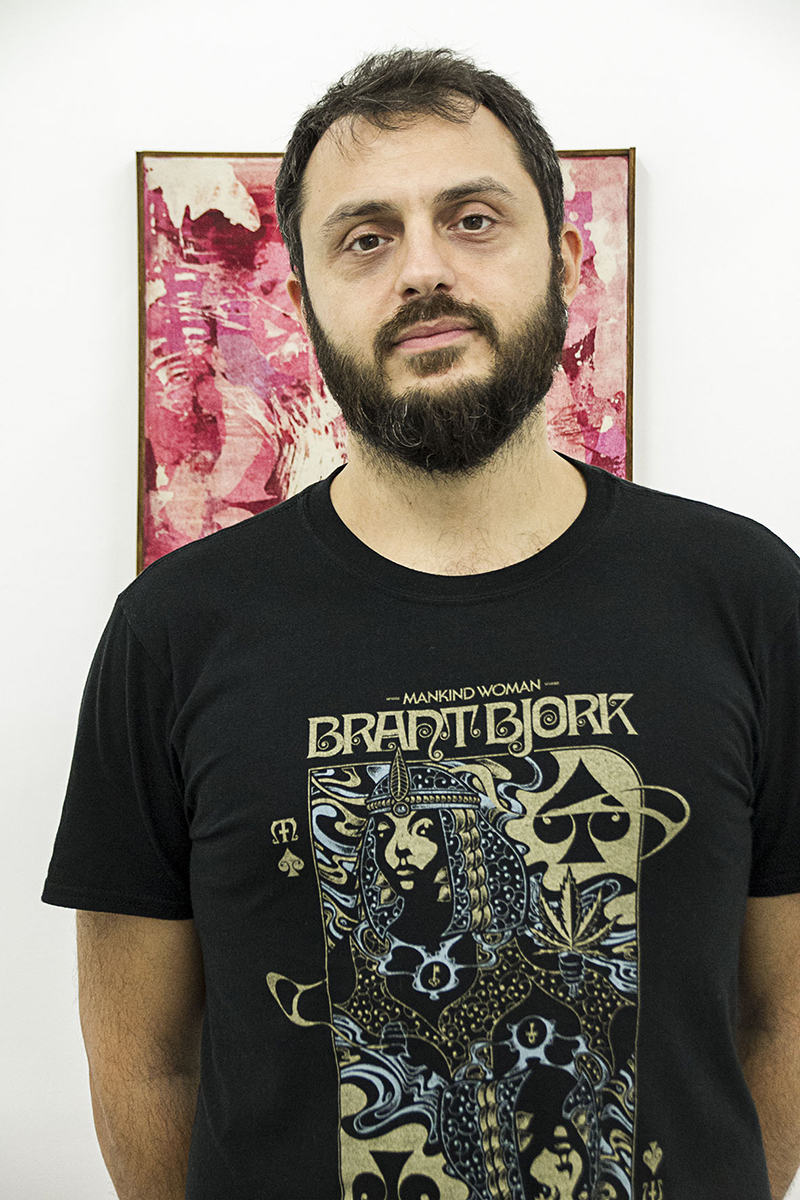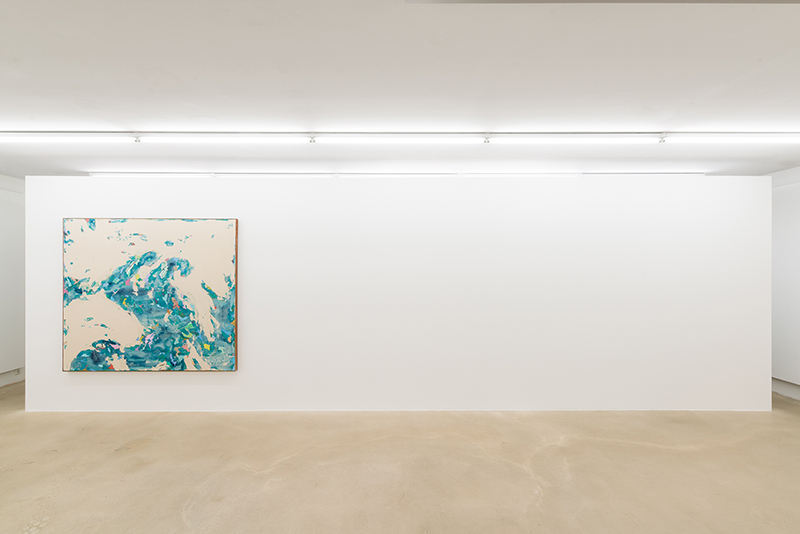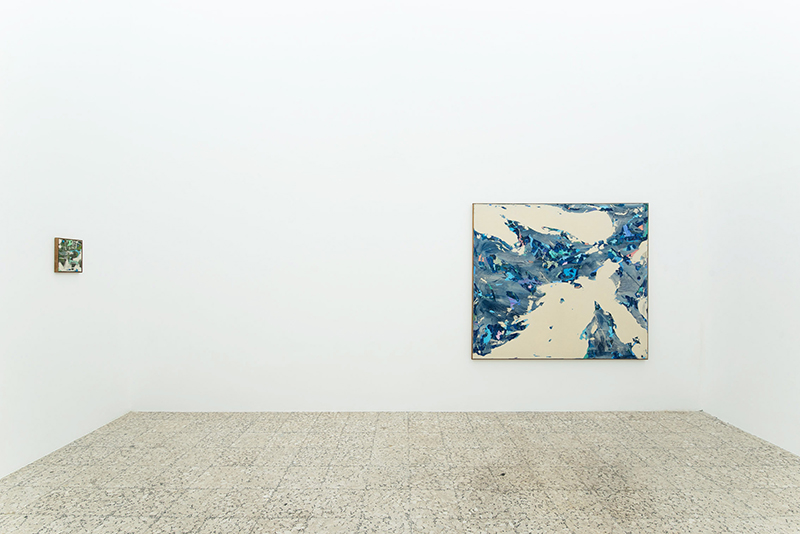Contemporary artist Yorgos Stamkopoulos approaches painting with a sculptural methodology.
My main inspiration is nature and music. The Greek sea landscape is stunning.. The forms and colour contradiction between the faded blue of the sky, the deep blue of the sea and the ochre of the dry islands during summer is amazing. I love flying over the Aegean Sea and observing the island clusters and the formalism they deploy.

Photo credit Laura Gianetti
How did your journey in art begin?
During my early childhood my father was working as a house painter and he would take me with him during my school summer breaks. I was fascinated when he would apply colour on the wall. He would paint a fresh white on an “old” white, or make tags with my name to amuse me. Well these were the first “Rothkos and Twomblys” for me. Back then I couldn’t see the significance of what he did and neither would he, as he has never been familiar with history of art. Eventually, I started painting and drawing the walls in my room – that led me to graffiti art. My parents supported me in taking drawing classes and some years later I was a student at the School of Fine Arts in Athens and then in Berlin.

Trajectory, 2017, Installation shot, Mario Iannelli Gallery, Rome, Photo Roberto Apa
Tell us about the evolution of your practice over the years.
My early works were mainly acrylic large scale colour fields made with either airbrushes or spray guns. These works had the aura and the effect of a horizon, as if someone was on a flight and he could see the earth from above. At a point those works were too clean and beautiful in a way and I had the urge to create a more chaotic space. So, I started using two spray guns – one filled with colour and one filled with water, in order to wash out colours off the canvas. The result was a more psychedelic abstraction and a really interesting effect in terms of formalism.
After a lot of reading I found the theoretical background as well and I was ready to pursue that direction even further. I started approaching painting with a more sculptural methodology and started using masking material. The works became multi-layered with an intense colour palette. The last few months I have been using oil colours again and the works have started to become more adequate and textured, more minimal with a thrift colour palette.

Another Perfect Day, 2019, Installation Shot, Nir Altman Gallery, Munich, Photo Dirk Tacke
What inspires you? Take us through your process and continuous frameworks of reference.
Well my main inspiration is nature and music. The Greek sea landscape is stunning for me. The forms and the colour contradiction between the faded blue of the sky, the deep blue of the sea and the ochre of the dry islands during summer is amazing. I love flying over the Aegean Sea and observing the island clusters and the formalism they deploy. I mostly listen to music while travelling as I love gazing around. The bands that accompany my travels and studio sessions are YOB, Carlton Melton and White Hills, just to name a few. Their heavy, melancholic, psychedelic and well-structured sounds can easily be found gesturally on my canvasses.
How do you balance art and life?
It is a hard thing to do, to be honest. I avoid anything art-related once I’m home. It is my sanctuary, therefore no emails, no research or blogging happens there. Friends and daily routine help me reset my state of mind and be more focussed on them in order to enjoy the small things that are important as an individual and not as an artist.

Soul Remains, 2016, Installation shot, Nathalie Halgand Gallery, Vienna, Photo Julian Mullan
How do you deal with the conceptual difficulty and uncertainty of creating work?
I mainly read to break free from any boundaries that Ι might have. I am trying to experiment a lot in the studio to find new qualities as well. Exhibition texts, catalogue essays, philosophy… they all enhance conceptual thinking and allow for depth of observation. Many times topics of discussion will arise through these mediums and open up a dialogue with fellow artists. Overall, I just keep pushing my boundaries until I get results that satisfy me and make me feel that my work is being more solid.
How does your audience interact and react to your work?
That is something that I cannot really tell as it is very subjective and personal. I believe that people need some time to think and reflect upon artworks. It is necessary to take time in order to think and comprehend. Therefore, I never try to engage in a conversation with someone that just saw a work or an exhibition of mine. I give the time and the space to my audience to come to me and ask me to clarify the way I work, with the aim being a deeper understanding.

Trajectory, 2017, Installation shot, Mario Iannelli Gallery, Rome, Photo Roberto Apa
What are you looking for when you look at other artists’ work? Who are your maestros?
I try to find the hidden meanings that are not visible on the first reading of the work – like texture, transparency, or a significant value that adds to the conceptual outcome of the work. A great source was the Caravaggio show at the Museum of Cycladic Art in Athens back in 2006, just before I moved to Berlin. I was stunned by the vulgar brushstrokes on the background that were only visible if you stood in front of a masterpiece. His work is still a primary force for me, same as Rothko. I was amazed by the luminosity of his black paintings the first time I encountered them at Tate Modern. I sat in the room longer than an hour trying to figure out what was going on and how was that possible.

As Time Goes By, 2019, Installation shot, Eins Gallery, Limassol, Photo Mirka Koutsouri
How does your interaction with a curator, gallery or client evolve? How do you feel about commissions?
It takes time and effort. For me it is all about trust and freedom. I am listen to what the collaborator has to say and take into consideration her or his worries, notes and ideas. Of course, as the collaborator varies, which could be a curator, a client, a gallery or an artist, the parameters that need to be noticed varies as well. An excellent example of such collaboration was my solo show Trajectory, which I did in Rome at Mario Iannelli gallery in 2017. Mario was very supportive of the idea of making an in situ experimental exhibition, which would bring the lines of my painting to life. The lines became sculptures and the walls my canvas. Lorenzo Bruni happily contextualised the show with his text. The three of us discussed the initial idea as the main core of this experiment and worked further.

No Superior Side, 2016, Installation shot, COSAR HMT, Düsseldorf, Photo Bela Pablo Jansen
What are you working on now? What’s coming next season?
I’m back in the studio after a two-month break and I will say at the moment I’m a bit more introverted. I want to develop my work fatalistically and push it a bit further. Therefore, I am trying different mediums and textures. There are some exhibitions on track for 2020 but I’m not allowed to reveal much at the moment.
Before you go – you might like to browse our Artist Interviews. Interviews of artists and outliers on how to be an artist. Contemporary artists on the source of their creative inspiration.












Add Comment